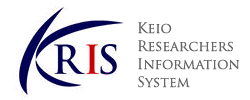-
Affiliation
-
School of Medicine, Department of Surgery (General and Gastroenterological Surgery) (Shinanomachi)
-
Position
-
Assistant Professor/Senior Assistant Professor

KEIO RESEARCHERS INFORMATION SYSTEM |
Details of a Researcher
このページはJavascriptを使用しています。すべての機能を使用するためにはJavascript を有効にする必要があります。
Hasegawa, Yasushi
|
|
|
Nakano Y., Abe Y., Udagawa D., Kitago M., Hasegawa Y., Hori S., Tanaka M., Uemura S., Odaira M., Mihara K., Nishiyama R., Chiba N., Hayatsu S., Kawachi S., Kitagawa Y.
World Journal of Surgical Oncology 23 ( 1 ) 2025.12
Laparoscopic cholecystectomy with synchronous navigation of ICG fluorescence and Yellow Enhance mode
Sonoda K., Abe Y., Kitago M., Yagi H., Hasegawa Y., Hori S., Tanaka M., Nakano Y., Kojima H., Kitagawa Y.
Asian Journal of Surgery 48 ( 7 ) 4186 - 4187 2025.07
ISSN 10159584
Uemura S., Hasegawa Y., Obara H., Kitago M., Yagi H., Abe Y., Hori S., Tanaka M., Nakano Y., Kitagawa Y.
Livers 5 ( 2 ) 2025.06
Usui S., Chu P.S., Hirano M., Hasegawa Y., Ueno A., Nomura R., Obara H., Kitagawa Y., Kanai T., Nakamoto N.
Clinical Journal of Gastroenterology 18 ( 3 ) 514 - 519 2025.06
ISSN 18657257
Tsuzaki J., Ueno A., Masugi Y., Tamura M., Yamazaki S., Matsuda K., Kurebayashi Y., Sakai H., Yokoyama Y., Abe Y., Hayashi K., Hasegawa Y., Yagi H., Kitago M., Jinzaki M., Sakamoto M.
Japanese Journal of Clinical Oncology 55 ( 4 ) 362 - 371 2025.04
ISSN 03682811
Shimata K., Yoon Y.I., Hibi T., Morinaga J., Narayanan A.K., Toshima T., Ito T., Akamatsu N., Kotera Y., Hong S.K., Hasegawa Y., Umeda Y., Reddy M.S., Ong A.D.L., Sivaprasadan S., Varghese J., Sugawara Y., Chen C.L., Nakayama N., Mochida S., Tanaka A., Suh K.S., Ikegami T., Lee K.W., Lee S.G.
American Journal of Transplantation 24 ( 11 ) 2139 - 2140 2024.11
ISSN 16006135
Noguchi F., Chu P.s., Yoshida A., Taniki N., Morikawa R., Hasegawa Y., Yamataka K., Hoshi H., Kasuga R., Tabuchi T., Ebinuma H., Shinoda M., Obara H., Kitagawa Y., Kanai T., Nakamoto N.
Clinical Gastroenterology and Hepatology (Clinical Gastroenterology and Hepatology) 20 ( 11 ) 2641 - 2643.e3 2022.11
ISSN 15423565
肝移植患者の腸内細菌叢が肝障害を惹起する
基盤研究(C), Principal investigator
MEDICAL PROFESSIONALISM 6
2025
ADVANCED MEDICAL TECHNOLOGIES
2025
MEDICAL PROFESSIONALISM 6
2024
ADVANCED MEDICAL TECHNOLOGIES
2024
ADVANCED MEDICAL TECHNOLOGIES
2023